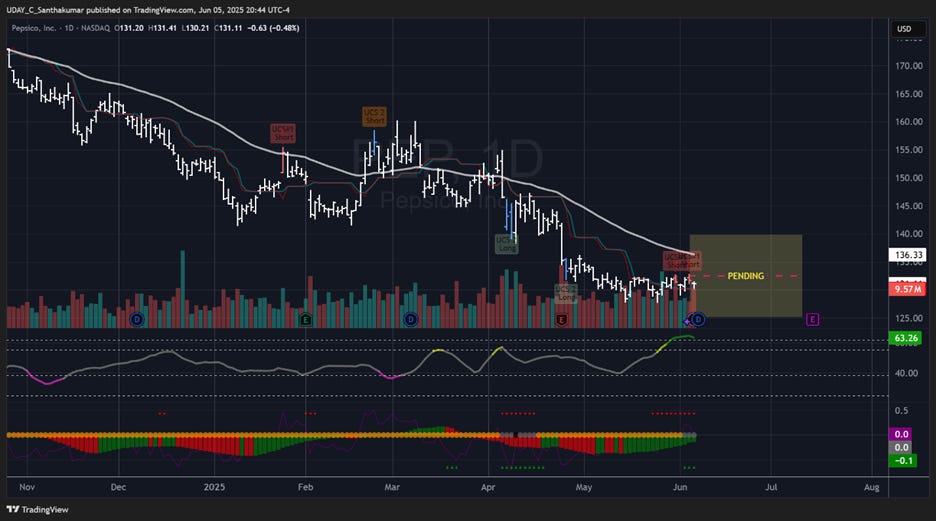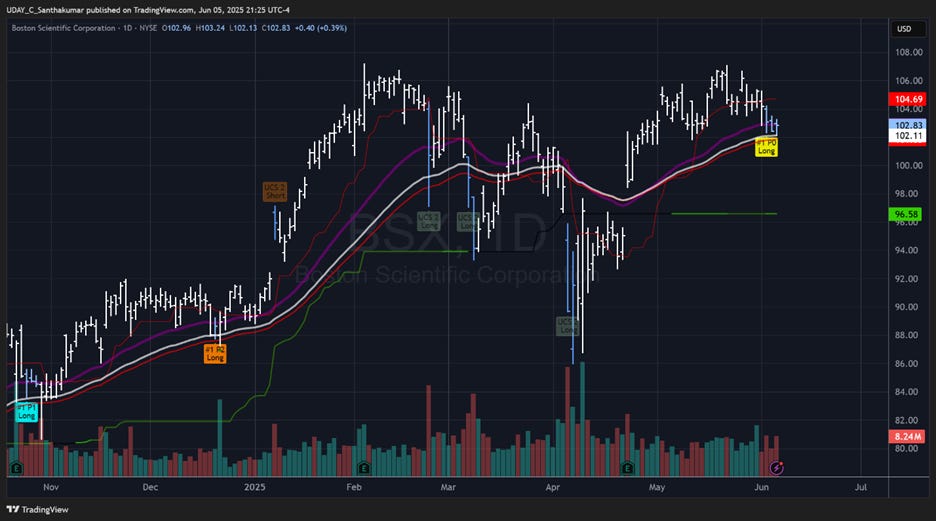UCS Market Framework — June 6, 2025
There are four major patterns I see often in the stock market. This utilized a few my own indicator namely UCS_Stretch, UCS_Ultimate Squeeze, UCS_RSG, UCS_Probability to Bounce, Top & Bottom Candles (Combinations of these)
1. UCS#1 – Pullback (Back Ratio for full Debit or Naked Long Options)
Continuation setups after retracements — where reward expands and risk compresses. Great for participating in the next leg of a rally or trend resumption. Volatility is often low, making this a cheap directional setup..
2. UCS#2 – Pullback Extended (Binary Option)
Quick reaction trades at key support/resistance after an overstretched move. Ideal for short-duration, risk-defined setups with strong R:R = 1:1.
3. UCS#3 – Deviation from Mean (Credit Spread OTM)
Overextensions away from mean value. Probabilistic edge favors mean reversion. Theta-positive setup with high win probability and limited risk — best when IV is elevated.
4. UCS#4 – Squeeze with Optimal Entry (Long Iron Condor or Back Ratio Spread)
Energy is compressing. Volatility is low. My RSG rating system highlights when it’s ready to explode — with direction or within a widening range.
TICKER 1 – PEP (PepsiCo)
Setup – UCS#4: Ultimate Squeeze Setup Confirmed
We're in a confirmed volatility compression zone, with resistance dominating the squeeze. The Ready-Set-Go (RSG) model is signaling SET — a critical phase right before expansion.
Strategy Insight:
The GO phase typically follows a breakout or fake-out, often accompanied by a surge in implied volatility. That makes the SET phase the optimal moment to build positions, before IV spikes inflate option premiums.
My Plan:
Primary setup: Long Iron Condor, 40–50 DTE, to exploit low volatility and range-bound expectations during compression
Alternative: Back Ratio Spread, if IV skew is favorable — that is, if IV on the short leg is higher than on the long leg, improving cost-efficiency and payoff skew
Note: PEP’s defensive nature means fake-outs are common — confirmation matters. To save my mental health, I prefer to setup bi-directional trades, and manage the outcome.
Actual Trade:
BUY +1 IRON CONDOR PEP 100 (Weeklys) 11 JUL 25 137/139/126/124 CALL/PUT @1.00 LMT
Ticker 2 – BSX (Boston Scientific Corporation)
Setup – UCS#1: Pullback (Back Ratio for Full Debit Spread)
BSX has pulled back to familiar support — assuming it holds and price breaks the double top resistance capping the upside, for a trend continuation. This kind of setup fits the UCS#1 framework: a healthy pullback within trend, potentially ready to break out or reject sharply from resistance.
Strategy Insight:
The double top adds a layer of structural resistance, so timing and positioning are key. If implied volatility favors the short strike (i.e., higher IV on the sell leg than on the long leg), a Back Ratio Debit Spread can offer a low-cost, asymmetric reward setup to capture continuation or breakout momentum.
My Plan:
Deploy a Call Back Ratio Spread if resistance is tested again and IV skew confirms
Limiting potential loss if the stock keeps falling, compared to long calls option trade.
Actual Trade:
BUY +1 2/2/-2 CUSTOM BSX 100 (Weeklys) 25 JUL 25/25 JUL 25/25 JUL 25 103/102/97 CALL/PUT/PUT @6.53 LMT
Disclaimer:
I am NOT a licensed financial advisor, investment professional, or registered broker-dealer. The strategies, indicators, and trade ideas shared here are for educational and informational purposes only. They reflect my personal opinions, research, and trading approach.Trading options and financial markets involves risk. Please consult with a qualified financial advisor or conduct your own due diligence before making any investment decisions. Use of this information is at your own risk.


